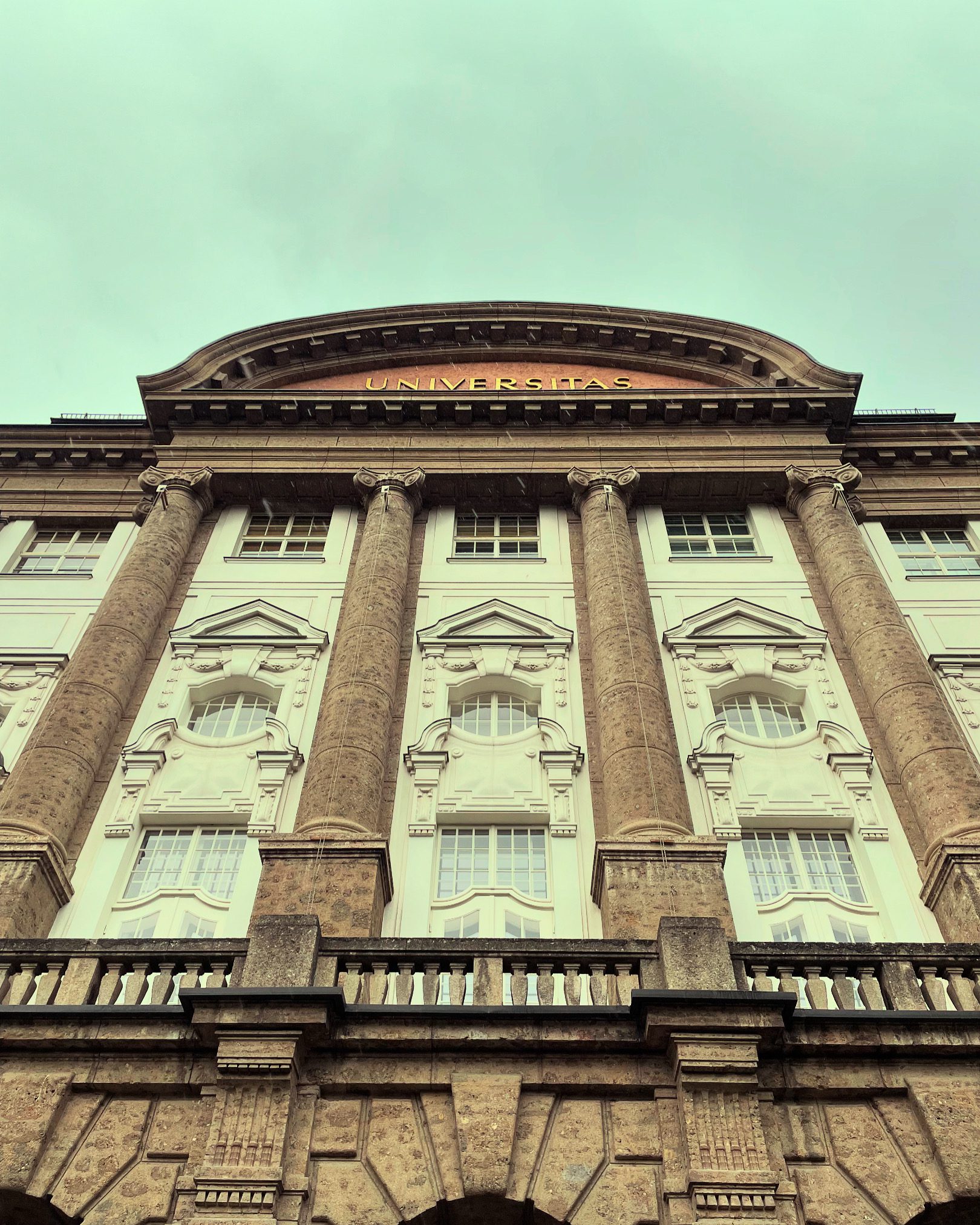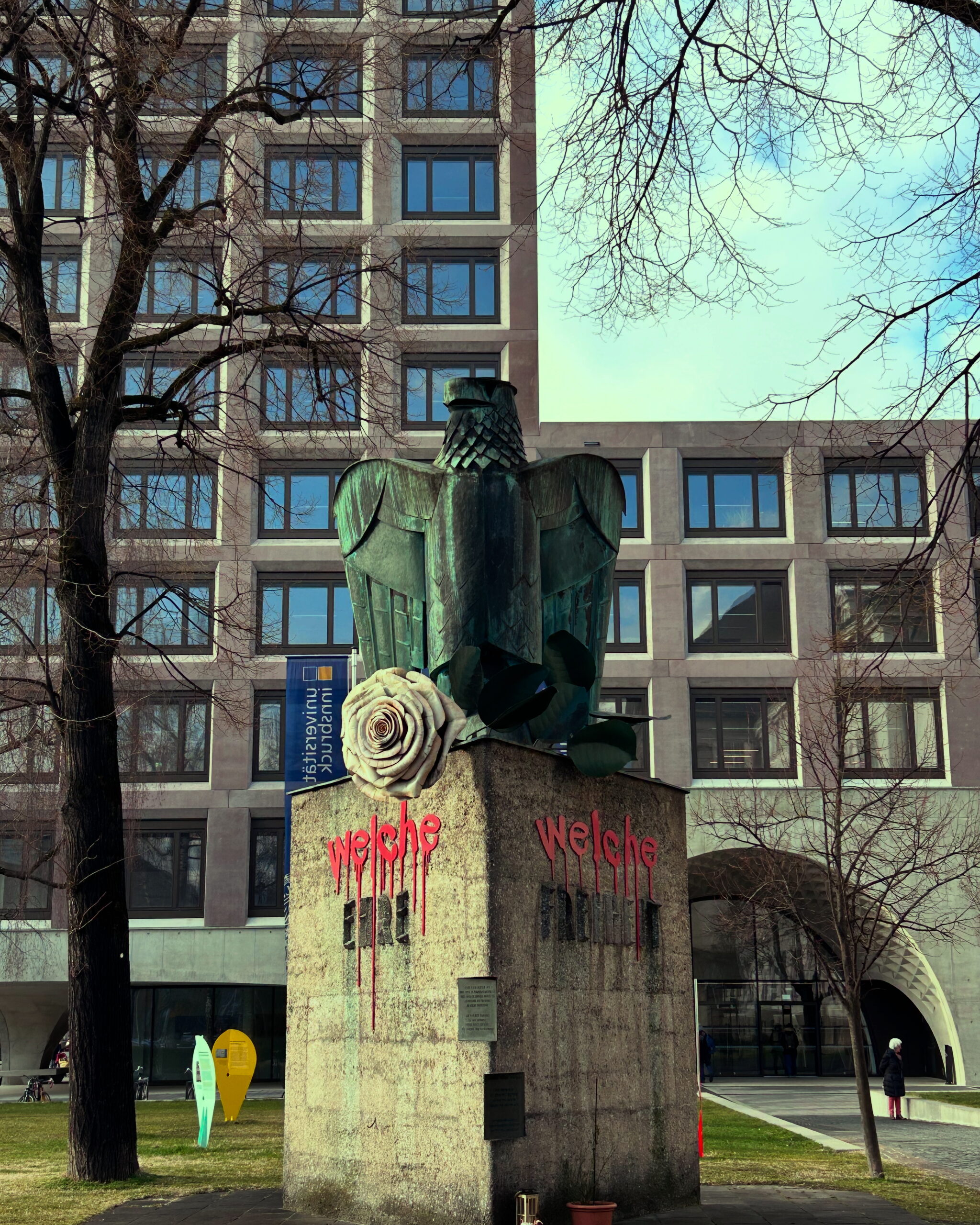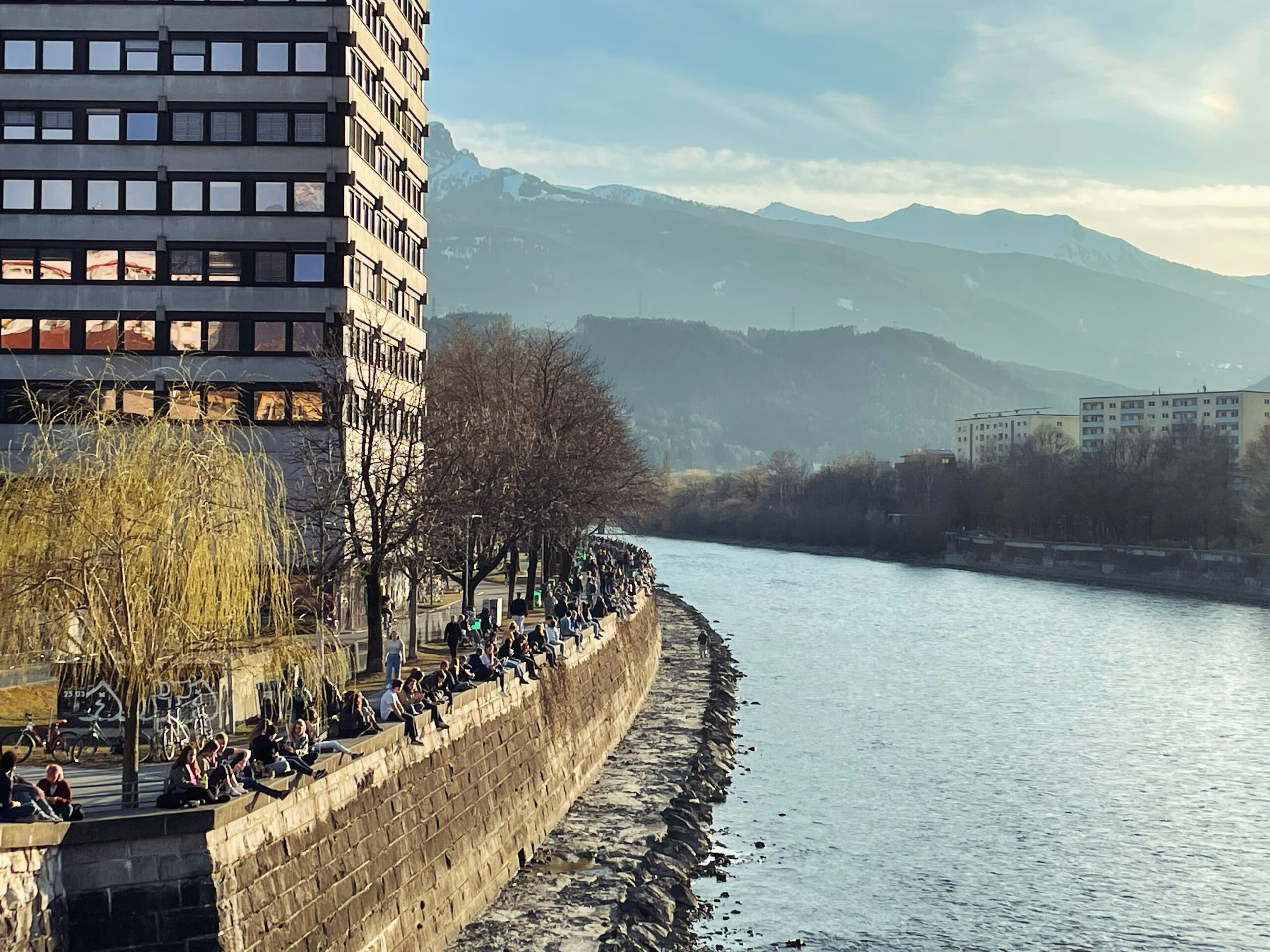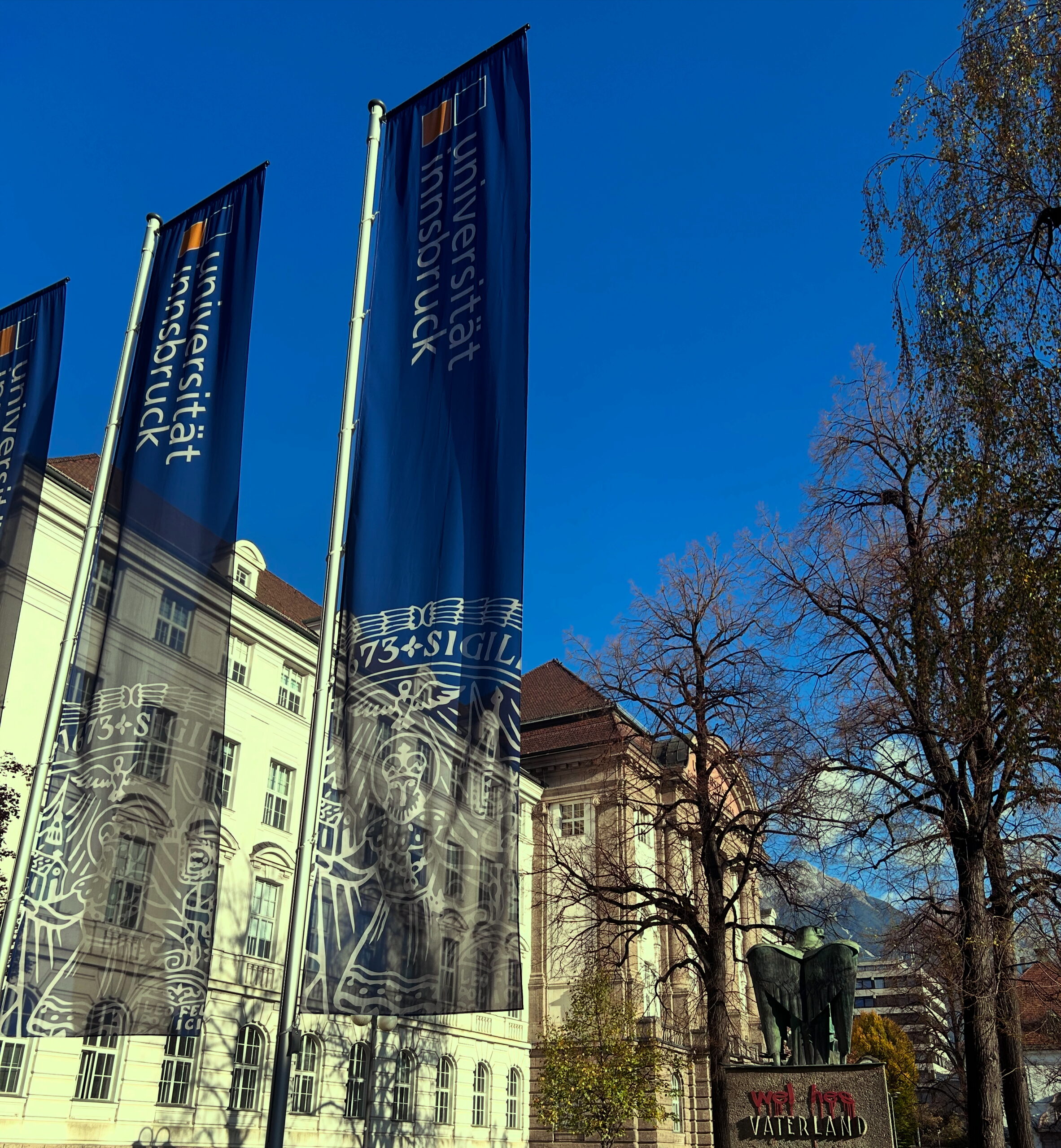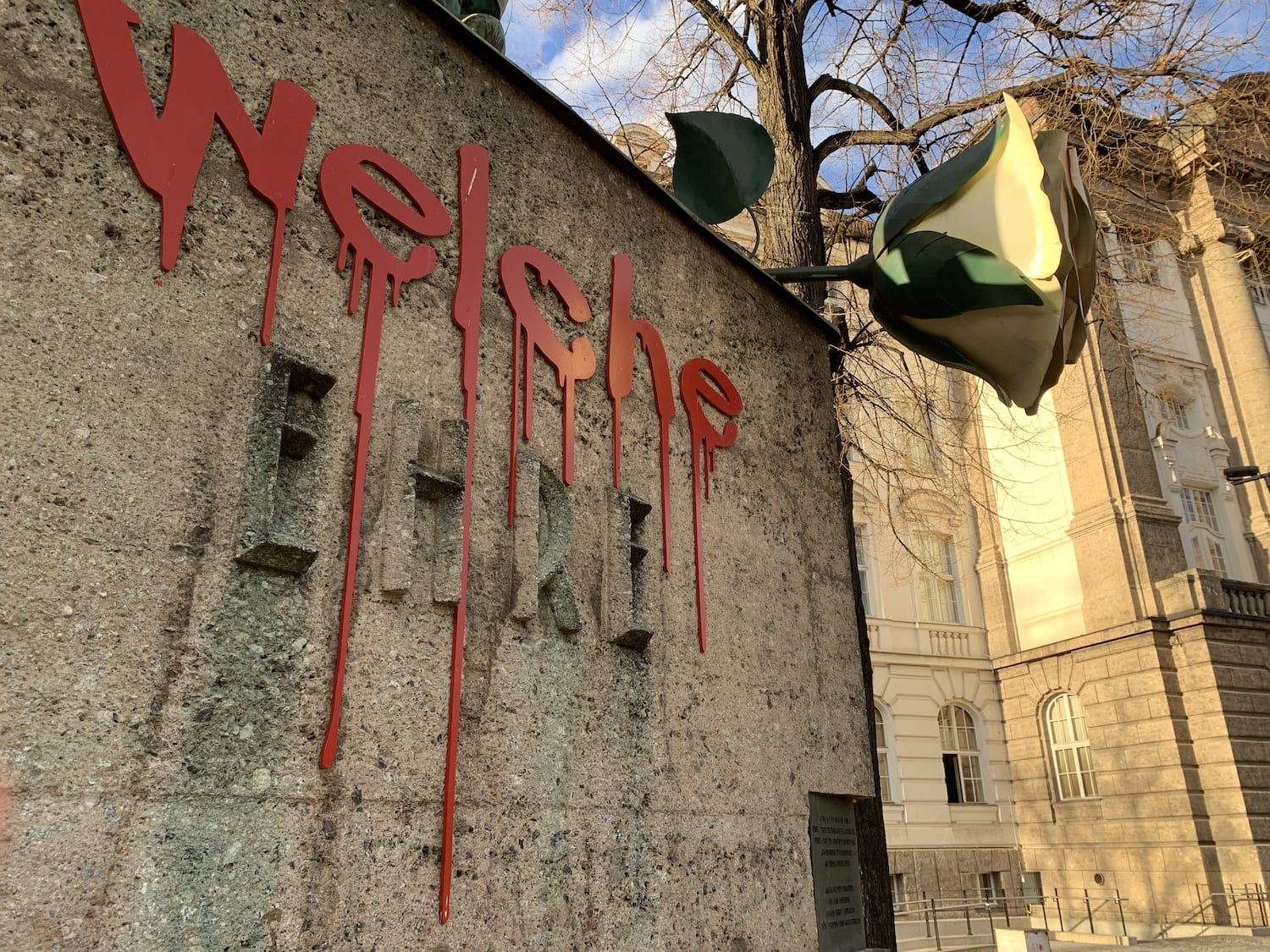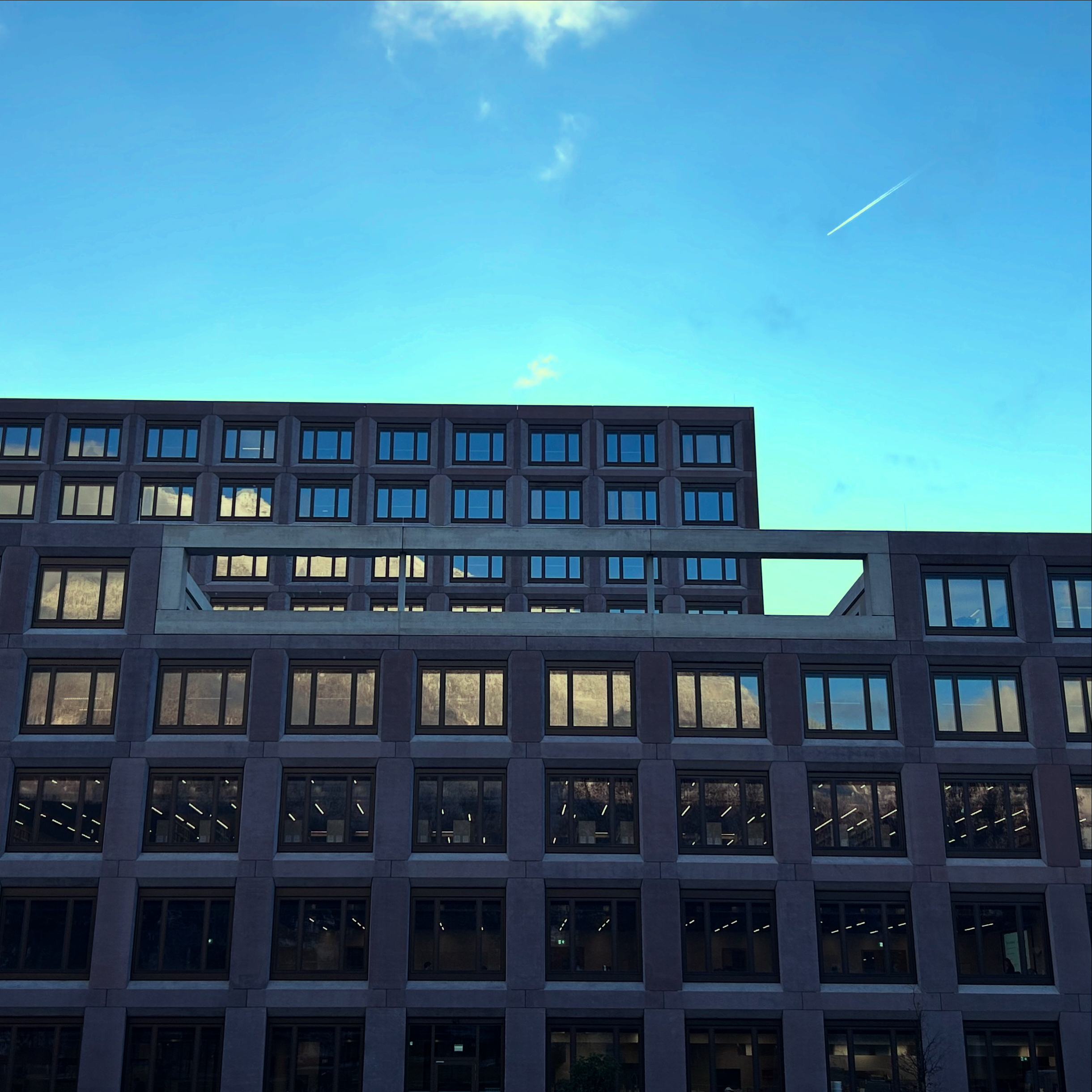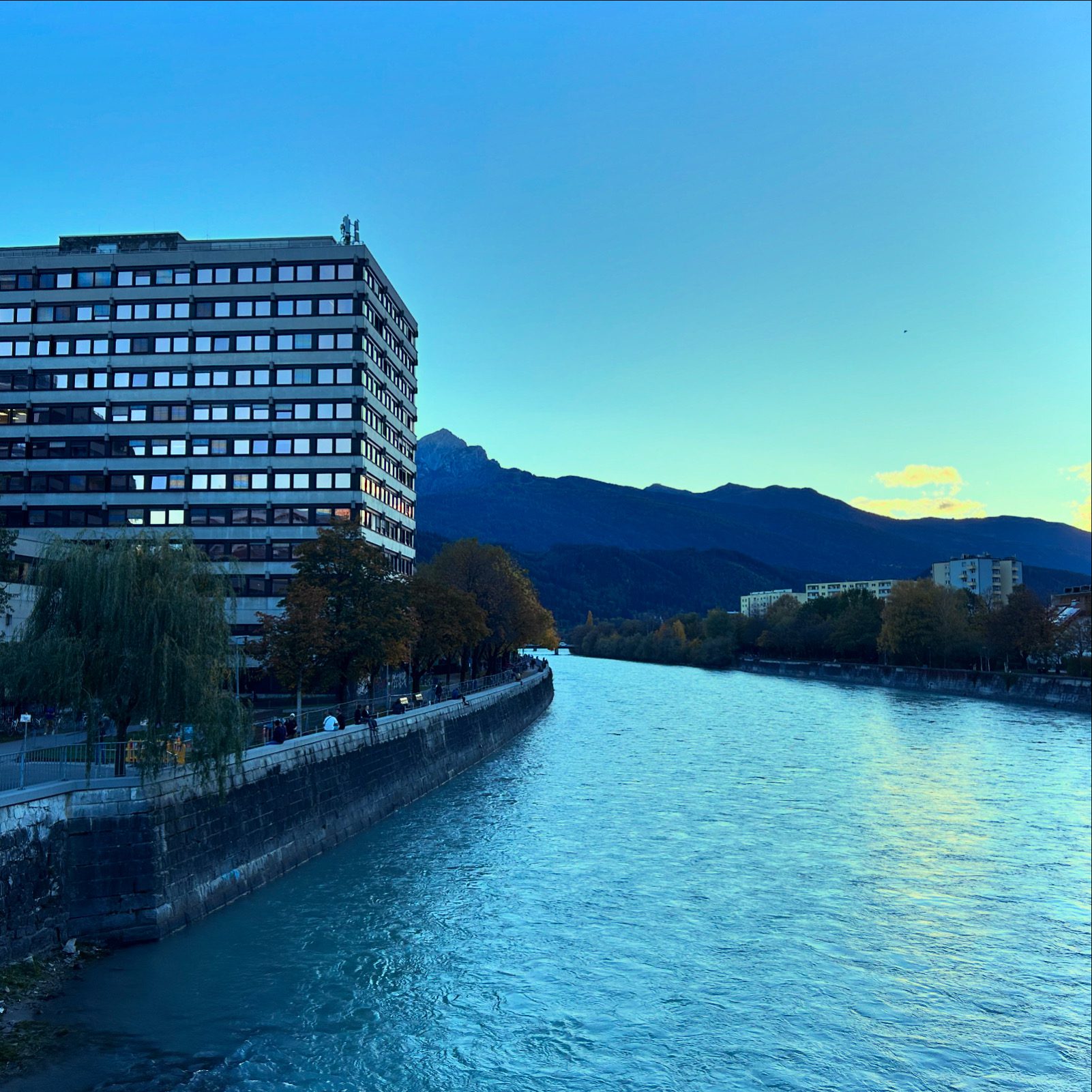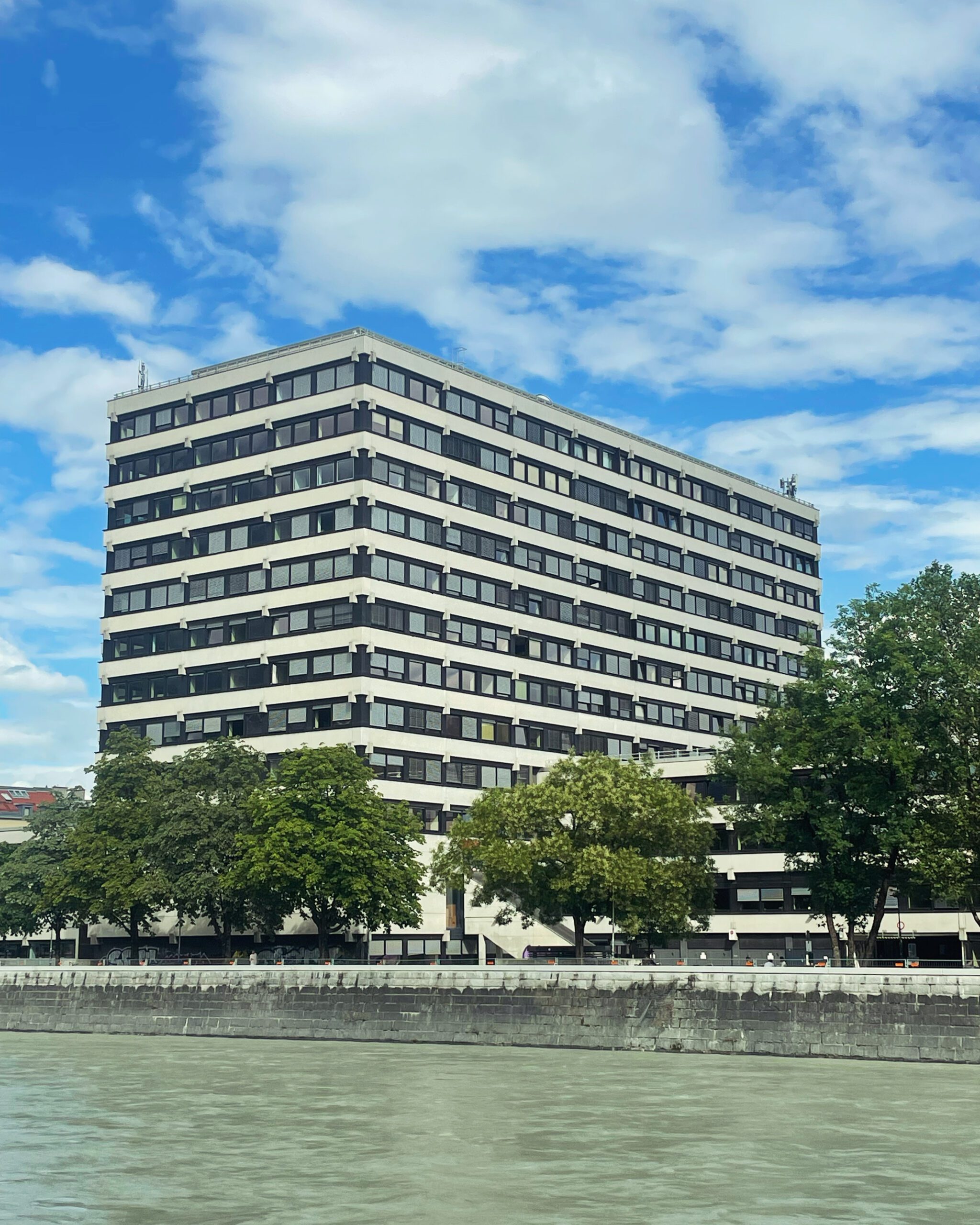University of Innsbruck
Innrain 52
Worth knowing
Die Universität ist einer der größten Arbeitgeber und mit den vielen Standpunkten zwischen Flughafen und Rossau der größte Immobiliennutzer Innsbrucks. Ursprünglich war der Standort der Universität nicht am Innrain, sondern in der Herrengasse in der Nähe der Pfarrkirche St. Jakob. Platzmangel zwang die Studierende und Professoren zum Umzug an den damaligen Stadtrand. Ab 1914 erfolgte beginnend mit der Bibliothek der Umzug. Noch vor ihrer Fertigstellung wurde die Universität zum ersten Mal zweckentfremdet. Während der Kriegsjahre wurden die halbfertigen Räumlichkeiten als Militärspital verwendet.
Over the course of time, the University am Innrain has been continuously expanded to cope with the increasing number of faculties and students. Particularly worth seeing in the library is the old reading room, which is still very popular with students today as a stylish place to study. Today, the entire campus is a self-contained, not uninteresting composition of different architectural styles from the 20th and 21st centuries. The modern Agnes-Heller-Haus blends in surprisingly harmoniously with the neo-baroque buildings next to the GeiWI tower. To the west of this is a student hall of residence.
The forecourt is controversial, with the square designed by Lois Welzenbacher. Memorial, das an die gefallenen Universitätsangehörigen des 1. Weltkriegs erinnert. Welzenbacher fühlte sich wie viele Vertreter der Architektur und Kunst der Moderne der 1920er Jahre vom aufregenden und neuen, das faschistische Bewegungen ausstrahlte, angezogen. Damit war er keine Ausnahme. Eine großdeutsche Grundeinstellung war in der Bevölkerung bis in die 1980er Jahre weit verbreitet. Burschenschafter verschiedener Verbindungen bewegten sich ideell zwischen großdeutschem Nationalismus, konservativ-katholischem Austrofaschismus und Nationalsozialismus. Wissenschaftlicher Antisemitismus sowie Antisozialismus waren salonfähig unter Akademikern der Zeit. Prorektor Theodor Rittler weihte das Denkmal mit den Worten ein: „Deutschland, dein Reich komm!“ Der burschenschaftliche Wahlspruch „Ehre – Freiheit – Vaterland“ wurde erst 2019 jeweils um das Wort „Welche“ erweitert. Mit der Umbenennung des Platzes in Christoph-Probst-Platz wird dem Innsbrucker Medizinstudenten gedacht, der 1943 als Mitglied der Widerstandsgruppe Weiße Rose was executed. A memorial plaque on the Memorial A second plaque commemorates the liberation theologians Ignacio Ellacuría and Segundo Montes, two graduates of the University of Innsbruck who were murdered by the regime in San Salvador in 1989.
Auf der Rückseite zum Inn hin treffen sich junge Menschen in entspannter Atmosphäre. Das Mäuerchen oberhalb des Inns, besser bekannt als Sun deck, wurde in den letzten Jahren zu einem veritablen Diskussionspunkt in der Stadtpolitik. Der studentische Ansatz des konsumlosen Zusammentreffens im öffentlichen Raum trifft auf die Ordnungswut städtischer Beamter und Politiker. Vor allem die Abfallfrage ist zu klären, bevor das Sonnendeck als offizieller Bestandteil des Campus genutzt werden kann.
1669 is considered the official founding year of the University of Innsbruck. On 15 October, Emperor Leopold I granted the Tyroleans the privilege of "Haller Salzaufschlags", which made it possible to tax the coveted commodity more heavily and thus finance university operations. The university emerged from the Latin school, which had been founded by the Jesuits under Ferdinand I just over a hundred years earlier. Latin and Greek were the main subjects taught. Academic books were still written in Latin in the early modern period. Latin was also a prerequisite for higher positions in the civil service. The first faculty to start teaching was philosophy. Theology, law and medicine followed shortly afterwards. When Pope Innocent XI gave the university his blessing in 1677, it was already in full swing.
By 1665, Innsbruck had lost its status as a royal seat and thus its prestige and splendour. The university made up for this demotion somewhat by retaining the aristocracy, at least in the form of students. Many sons of aristocratic families were among the initial 300 students. Despite their social standing, the students were not necessarily ambitious model pupils, but rather boys who were used to a certain lifestyle and status. In January 1674, for example, "nit allein zu nächtlicher Zeit sich Ungelegenheiten, Rumores und ungereimte Handlungen“ und es wurden „Studenten der Universität angetroffen, die allerlei verbotene Waffen wie Feuerrohr, Pistolen, Terzerol, Stilett, Säbel, Messer…" had with them. Teenagers from the upper classes were used to carrying and using weapons. In the aristocracy, the concept of honour was of immense importance. As in the military, breaches of honour could also lead to duels in student circles. Fighting fraternities symbolically continue this tradition to this day. The encounters between privileged young people and burghers, servants and tradesmen did not always run smoothly either. This created the problem that although students were able to mingle with the city's inhabitants, they were subject to university law, which was separate from city law.
For a long time, women and sons of artisan families were not allowed to study at university. The first female doctor of law at the university was only celebrated in the press on 11 December 1923.
„Am kommenden Samstag wird an der Innsbrucker Universität Fräulein Mitzi Fischer zum Doktor iuris promoviert. Fräulein Fischer ist eine gebürtige Wienerin. In Wien absolvierte sie auch das Gymnasium. Nach der Reifeprüfung oblag sie dem juristischen Studium der Universität Innsbruck. Die zukünftige Doktorin hat sämtliche Prüfungen mit Auszeichnungen absolviert, müßte also nach dem früheren Brauche sub auspiciis imperatoris promovieren. Jedenfalls ist Fräulein Fischer die erste Dame, die sich an der Innsbrucker Universität den juristischen Doktortitel erwirbt.“
The university has always been a political issue. The name Leopold Franzens University goes back to the two emperors Leopold and Franz, under whom it was founded. The university was downgraded or closed twice before Emperor Franz I re-established it in 1826. The changes in the economy and society in the early years of industrialisation also had an impact on the university. In keeping with the spirit of the time, the opening speech by the Dean of the Faculty of Philosophy, Prof Dr Joachim Suppan (1794 - 1864), dealt with a practical problem of physics, namely "eine genauere Kenntnis der so wichtigen und nützlichen Erfindung der Dampfmaschine auch für die vaterländische Industrie, wo dieselbe bisher noch keine Anwendung hat" would be achieved. The fact that Supan was also an ordained priest in addition to his degrees in philosophy and mathematics shows the influence that the church had on the education system in the 19th century. Supan's final exhortation to the students shows how closely the university was linked to the state authorities alongside the church, „dereinst dem Vaterlande durch Kenntnis und Tugend ersprießliche Dienste zu leisten“.
With the annexation to the German Reich in 1938, the university was renamed once again. After the war, the German Alpine University again the Leopold Franzens University.
In the 20th and 21st centuries, teachers and students have repeatedly made sensational achievements in research. Victor Franz Hess was awarded the Nobel Prize in Physics during his time at the University of Innsbruck for his achievements in cosmic ray research. Quantum physicist Anton Zeilinger also worked at the University of Innsbruck, although not in 2022 when he was awarded the prize. The Nobel Prize for Chemistry was also awarded to Professors Fritz Pregel, Adolf Windaus and Hans Fischer, although they too were no longer working in Innsbruck.
The university is not only important for the city in intellectual and economic terms. 30,000 students populate and characterise life between the Nordkette and Patscherkofel mountains. You only realise how much the students enliven Innsbruck when the foreigners return home between semesters. Tens of thousands not only enliven the nightlife and ski slopes, but also give the small town an international flair and hip urbanity.
St Peter Canisius and the Jesuits
Jesuits, Franciscans, Premonstratensians, Carmelites, Servites, Capuchins, Ursulines. Visitors to Innsbruck usually walk past many monasteries without realising it. The Jesuits were probably the most politically influential order in the history of the city. The "Soldaten Christi" were founded by the former nobleman and officer Ignatius of Loyola (1491 - 1556). Loyola was a moral reformer. Unlike Luther, he wanted to change the church, but not without the Pope as its head. In their zeal for reform, the Jesuits focussed on better training for the clergy and higher moral standards based on Christian roots in everyday church life. Their most important contribution was the founding of schools and universities. Protestant countries and cities had begun to German schoolsacademies and grammar schools. As many subjects as possible should be able to read in order to find piety and salvation in individual and direct Bible reading. The Jesuits, on the other hand, concentrated on educating the elite and thus gained lasting influence in the centres of power of the Catholic states. Not only aristocrats, priests and politicians, but also civil servants were educated in schools and colleges.
The Jesuits founded the Latin school in Innsbruck, from which the university would later emerge. The new school had a major impact on the city's development. The intelligentsia was educated here, enabling Innsbruck's rise as an administrative and economic centre. Its activities were interrupted under Joseph II. He disempowered and expropriated ecclesiastical orders, including the Jesuits, whom he had little love for. Under him, the University of Innsbruck was downgraded to a lyceum in 1781. It was not until 1838 that the Jesuits were reappointed to Innsbruck. In addition to professorships at the university, they had the Theresianuma grammar school for the aristocracy, in a leading role.
Thanks to the educational system, skilful structures, discipline and organisation adopted from the military, the Order grew rapidly and managed to establish a special relationship with the Habsburgs during the Counter-Reformation. Many members of the dynasty can be recognised in their rule and actions as having been influenced by the order from which they received their education. Jesuits such as Bartholomew Viller or Wilhelm Lamormaini were politically influential as confessors and advisors to the Habsburgs in the early modern period. It is no coincidence that the Jesuits are still the adversaries of the Freemasons in countless conspiracy theories and novels and are regarded by many as the modern-day equivalent of the James Bond villain.
A keen supporter of the Jesuits in Tyrol was the Tyrolean prince and later Emperor Ferdinand I. Like Ignatius of Loyola, he had grown up in Spain. He had just as many difficulties with the customs of the Germans and the non-existent Reformation movement in Spain as he did with the language. The Tyrolean population, on the other hand, were alienated from their sovereign, who, with his foreign court, could easily be mistaken for an occupying power. A connecting element between the two worlds was the Roman Church, especially the Jesuits.
The Jesuits were very open to research, knowledge gathering and education and wanted to learn to understand the world in terms of Christian creation. For Catholics, this made them a hip antithesis to both the dusty existing orders and the Protestants. Faith and empiricism combined to form a kind of pre-modern science that attempted to explain nature and physics. Ferdinand II's collection at Ambras Castle bears witness to the thirst for research of the time, as do the alchemical experiments carried out by Emperor Matthias.
For all their love of science, mysticism also returned to everyday church life under the Jesuits. Passion plays, Easter sepulchres, processions and feast days were intended to soften the strict principles of the faith with drama and spectacle. The Marian Congregation, known as the MK in Innsbruck in the 1960s and 70s, was one of the largest youth centres in Europe. In a modern sense, it can certainly be seen in the tradition of the Church's gentle introduction to the faith and the education of young people.
The Jesuit order, fully committed to popular belief, was also highly motivated when it came to persecuting witches and people of other faiths. In the then recently discovered New World in America and Asia, the Jesuits were eager to proselytise the local pagan population. St Francis Xavier, one of Ignatius of Loyola's first companions, died on a missionary journey in China. In a side chapel of the Jesuit church in Innsbruck, this Soldaten Christi an altar was consecrated.
One of the most important Jesuit theologians was Petrus Canisius (1521 - 1597). The educated cleric quickly rose through the ranks of the newly founded Jesuit order and was installed by Emperor Ferdinand as one of the most important ecclesiastical politicians in the empire. During his travels across Europe, Petrus Canisius also spent some time in Innsbruck and played a key role in the establishment of the Jesuit order. He was both a confessor to the aristocracy and a churchman for the masses, reaching out to the rural population while travelling through the villages of Tyrol. He recognised that Latin was not the language to immunise peasants, farmhands and maids against Protestantism. With his catechism, Petrus Canisius wrote an important German-language collection of ideas in the Catholic struggle against the Protestant Reformation, which was translated into all languages and was long regarded as a guide for the Catholic Church.
Today, Karl-Rahner-Platz is not only home to the Jesuit Church, but also the Faculty of Theology at the University of Innsbruck. In Saggen, the Collegium Canisianum belongs to the Jesuits.
A First Republic emerges
Few eras are more difficult to grasp than the interwar period. The Roaring TwentiesJazz and automobiles come to mind, as do inflation and the economic crisis. In big cities like Berlin, young ladies behaved as Flappers with a bobbed head, cigarette and short skirts, lascivious to the new sounds, Innsbruck's population, as part of the young Republic of Austria, belonged for the most part to the faction of poverty, economic crisis and political polarisation.
Although the Republic of German-Austria had been proclaimed, it was unclear how things would continue in Austria. The monarchy and nobility were banned. The bureaucratic state of the k.u.k. Empire was seamlessly established under a new flag and name. As the successors to the old crown lands, the federal states were given a great deal of room for manoeuvre in legislation and administration within the framework of federalism. However, enthusiasm for the new state was limited. Not only was the supply situation miserable after the loss of the vast majority of the former Habsburg empire, but people also mistrusted the basic idea of the republic. The monarchy had not been perfect, but only very few people could relate to the idea of democracy. Instead of being subjects of the emperor, they were now citizens, but only citizens of a dwarf state with an oversized capital that was little loved in the provinces instead of a large empire. In the former crown lands, most of which were governed by Christian socialists, people liked to speak of the Viennese water headwho was fed by the yields of the industrious rural population.
Austria was deeply divided. Capital and provinces, city and countryside, citizens, workers and farmers - in the vacuum of the first post-war years, each group wanted to shape the future according to their own ideas. The divide did not only exist on a political level. Morality, family, leisure activities, education, faith, understanding of the law - every area of life was affected. Who should rule? How should wealth, rights and duties be distributed? What should be done with public buildings such as barracks, castles and palaces?
The revolution in Russia and the ensuing civil war with millions of deaths, expropriation and a complete reversal of the system cast a long shadow over Europe. The prospect of Soviet conditions made people afraid. A communist coup was not a real danger, especially in Tyrol, but could be easily instrumentalised in the media as a threat to discredit social democracy.
Italian troops occupied Innsbruck for almost two years after the end of the war. At the peace negotiations in Paris, the Brenner Pass was declared the new border. The historic Tyrol was divided in two. The military was stationed at the Brenner Pass to secure a border that had never existed before and was perceived as unnatural and unjust. Many people on both sides of the Brenner felt betrayed. Although the war was far from won, they did not see themselves as losers to Italy. Hatred of Italians reached its peak in the interwar period, even if the occupying troops were emphatically lenient. A passage from the short story collection "The front above the peaks" by the National Socialist author Karl Springenschmid from the 1930s reflects the general mood:
"The young girl says, 'Becoming Italian would be the worst thing.
Then old Tappeiner just nods and grumbles: 'I know it myself and we all know it: becoming a whale would be the worst thing'."
Die neu gegründete Tiroler Volkspartei stand Wien und der Sozialdemokratie gegenüber mindestens so ablehnend gegenüber wie den Italienern. Das neue Österreich erschien zu klein und nicht lebensfähig. Auch andere Bundesländer spielten mit dem Gedanken, sich von der Republik abzukoppeln, nachdem der von allen Parteien unterstützte Plan sich Deutschland anzuschließen von den Siegermächten des Ersten Weltkriegs untersagt worden war. Die Tiroler Pläne allerdings waren besonders spektakulär. Von einem neutralen Alpenstaat mit anderen Bundesländern, einem Freistaat bestehend aus Tirol und Bayern oder von Kufstein bis Salurn, einem Anschluss an die Schweiz bis hin zu einem katholischen Kirchenstaat unter päpstlicher Führung gab es viele Überlegungen. Der Anschluss an Deutschland erhielt in Tirol bei einer Abstimmung in Tirol einen Zuspruch von 98%, kam aber nie zustande.
However, high politics was only the framework for the real problems. The epidemic that went down in history as the Spanish flu also took its toll in Innsbruck in the years after the war. Exact figures were not recorded, but the number of deaths worldwide is estimated at 27 - 50 million. Many Innsbruck residents had not returned home from the battlefields and were missing as fathers, husbands and labourers. Many of those who had made it back were wounded and scarred by the horrors of war. As late as February 1920, the "Tyrolean Committee of the Siberians" at the Gasthof Breinößl "...in favour of the fund for the repatriation of our prisoners of war..." a charity evening.
Many people, especially civil servants and public sector employees, had lost their jobs after the League of Nations tied its loan to harsh austerity measures. Tourism as an economic factor was non-existent due to the problems in the neighbouring countries, which were also shaken by the war. It was only with the currency reorganisation and the introduction of the schilling as the new currency in 1925 under Chancellor Ignaz Seipel that Innsbruck slowly began to recover.
Die erste Republik war eine schwere Geburt aus den Überbleibseln der einstigen Monarchie und sie sollte nicht lange halten. Trotz vielen Nachkriegsproblemen passierte in der Ersten Republik aber auch viel Positives. Aus Untertanen wurden Bürgern. Was in der Zeit Maria Theresias begann, wurde nun unter neuen Vorzeichen weitergeführt. Der Wechsel vom Untertanen zum Bürger zeichnete sich nicht nur durch ein neues Wahlrecht, sondern vor allem durch die verstärkte Obsorge des Staates aus. Schulen, Kindergärten, Arbeitsämter, Krankenhäuser und städtische Wohnanlagen traten an die Stelle des Wohlwollens reicher Bürger, der Monarchie und der Kirche. Die Zeiten waren schwer und das neue System noch nicht eingeschliffen.
Bis heute basiert vieles im österreichischen Staatswesen sowie im Innsbrucker Stadtbild und der Infrastruktur auf dem, was nach dem Zusammenbruch der Monarchie entstanden war. In Innsbruck gibt es keine bewussten Erinnerungsorte an die Entstehung der Ersten Republik in Österreich. Die denkmalgeschützten Wohnbauprojekte wie der Schlachthofblock, der Pembaurblock oder der Mandelsbergerblock im Saggen sowie in Pradl und Wilten sind Stein gewordene Zeitzeugen.
The First World War and the Italian occupation
Beinahe hätte nicht Gavrilo Princip, sondern ein Innsbrucker Student die Geschicke der Welt verändert. Es ist dem Zufall zu verdanken, dass der 20 Jahre alte Serbe im Jahr 1913 gestoppt wurde, weil er mit dem geplanten Attentat auf den Thronfolger vor einer Kellnerin prahlte. Erst als es tatsächlich zu den die Welt verändernden Schüssen in Sarajevo kam, erschien ein Artikel in den Medien dazu. Welche Auswirkungen der daraufhin ausgebrochene Erste Weltkrieg auf die Welt und den Alltag der Menschen haben sollte, war nach dem tatsächlichen Attentat auf Franz Ferdinand am 28. Juni nicht absehbar. Zwei Tage nach der Ermordung des Habsburgers in Sarajewo war aber in den Innsbrucker Nachrichten bereits prophetisches zu lesen: „Wir sind an einem Wendepunkte – vielleicht an dem Wendepunkte“ – der Geschicke dieses Reiches angelangt".
Enthusiasm for the war in 1914 was also high in Innsbruck. From the "Gott, Kaiser und Vaterland“ der Zeit angetrieben, begrüßten die Menschen den Angriff auf Serbien zum allergrößten Teil einhellig. Politiker, Klerus und Presse stimmten in den allgemeinen Jubel mit ein. Neben dem kaiserlichen Appell „An meine Völker“, der in allen Medien des Reiches erschien, druckten die Innsbrucker Nachrichten am 29. Juli, dem Tag nach der Kriegserklärung Österreich-Ungarns an Serbien einen Artikel rund um die Einnahme Belgrads durch Prinz Eugen im Jahr 1717. Der Ton war feierlich, wenn auch nicht ganz ohne Vorahnung auf das, was kommen sollte.
„Der Appell des Kaisers an seine Völker wird tief ergreifen. Der innere Hader ist verstummt und die Spekulationen unserer Feinde aus Unruhen und ähnliche Dinge sind jämmerlich zu Schanden geworden. In alter und vielbewährter Treue stehen vor allem auch diesmal die Deutschen zu Kaiser und Reich: auch diesmal bereit, mit ihrem Blute für Dynastie und Vaterland einzustehen. Wir gehen schweren Tagen entgegen; niemand kann auch nur ahnen, was uns das Schicksal bescheiden wird, was es Europa, was es der Welt bescheiden wird. Wir können nur mit unserem alten Kaiser auf unsere Kraft und auf Gott vertrauen und die Zuversicht hegen, daß, wenn wir einig find und zusammenhalten, uns der Sieg beschieden sein muß, denn wir wollten den Krieg nicht und unsere Sache ist die der Gerechtigkeit!“
Besonders „verdient“ machten sich bei der Kriegstreiberei Theologen wie Joseph Seeber (1856 – 1919) und Anton Müllner alias Bruder Willram (1870 - 1919) who, with her sermons and writings such as "Das blutige Jahr" elevated the war to a crusade against France and Italy.
Many Innsbruckers volunteered for the campaign against Serbia, which was thought to be a matter of a few weeks or months. Such a large number of volunteers came from outside the city to join the military commissions that Innsbruck was almost bursting at the seams. Nobody could have guessed how different things would turn out. Even after the first battles in distant Galicia, it was clear that it would not be a matter of months.
In 1915, the Kingdom of Italy entered the war on the side of France and England. This meant that the front went right through what was then Tyrol. From the Ortler in the west across northern Lake Garda to the Sextener Dolomiten the battles of the mountain war took place. Innsbruck was not directly affected by the fighting. However, the war could at least be heard as far as the provincial capital, as was reported in the newspaper of 7 July 1915:
„Bald nach Beginn der Feindseligkeiten der Italiener konnte man in der Gegend der Serlesspitze deutlich Kanonendonner wahrnehmen, der von einem der Kampfplätze im Süden Tirols kam, wahrscheinlich von der Vielgereuter Hochebene. In den letzten Tagen ist nun in Innsbruck selbst und im Nordosten der Stadt unzweifelhaft der Schall von Geschützdonner festgestellt worden, einzelne starke Schläge, die dumpf, nicht rollend und tönend über den Brenner herüberklangen. Eine Täuschung ist ausgeschlossen. In Innsbruck selbst ist der Donner der Kanonen schwerer festzustellen, weil hier der Lärm zu groß ist, es wurde aber doch einmal abends ungefähr um 9 Uhr, als einigermaßen Ruhe herrschte, dieser unzweifelhafte von unseren Mörsern herrührender Donner gehört.“
Until the transfer of regular troops from the eastern front to the Tyrolean borders, the national defence depended on the Standschützen, a troop consisting of men under 21, over 42 or unfit for regular military service.
The front was relatively far away from Innsbruck, but the war penetrated civilian life. This experience of the total involvement of society as a whole was new to the people. Barracks were erected in the Höttinger Au to house prisoners of war. Transports of wounded brought such a large number of horribly injured people that many civilian buildings such as the university library, which was currently under construction, or Ambras Castle were converted into military hospitals. The Pradl military cemetery was established to cope with the large number of fallen soldiers. A predecessor to tram line 3 was set up to transport the wounded from the railway station to the new garrison hospital, today's Conrad barracks in Pradl. The population in Innsbruck suffered from shortages, especially in the last winter, which was known as the Hunger winter went down in European history. In the final years of the war, food was supplied via ration coupons. 500 g of meat, 60 g of butter and 2 kg of potatoes were the basic diet per person - per week, mind you. Archive photos show the long queues of desperate and hungry people outside the food shops.
In October 1918, the first air raid alert was sounded, but no damage was done. At this time, most people were already aware that the war was lost and what fate awaited Tyrol, as this article from 6 October 1918 shows:
„Aeußere und innere Feinde würfeln heute um das Land Andreas Hofers. Der letzte Wurf ist noch grausamer; schändlicher ist noch nie ein freies Land geschachert worden. Das Blut unserer Väter, Söhne und Brüder ist umsonst geflossen, wenn dieser schändliche Plan Wirklichkeit werden soll. Der letzte Wurf ist noch nicht getan. Darum auf Tiroler, zum Tiroler Volkstag in Brixen am 13. Oktober 1918 (nächsten Sonntag). Deutscher Boden muß deutsch bleiben, Tiroler Boden muß tirolisch bleiben. Tiroler entscheidet selbst über Eure Zukunft!“
On 4 November, Austria-Hungary and the Kingdom of Italy finally agreed an armistice. This gave the Allies the right to occupy areas of the monarchy. The very next day, Bavarian troops entered Innsbruck. Austria's ally Germany was still at war with Italy and was afraid that the front could be moved closer to the German Reich in North Tyrol. Fortunately for Innsbruck and the surrounding area, however, Germany also surrendered a week later on 11 November. This meant that the major battles between regular armies did not take place.
Nevertheless, Innsbruck was in danger. Huge columns of military vehicles, trains full of soldiers and thousands of emaciated soldiers making their way home from the front on foot passed through the city. The city not only had to keep its own citizens in check and guarantee rations, but also protect itself from looting. In order to maintain public order, defence groups were formed from schoolchildren, students, workers and citizens. On 23 November 1918, Italian troops occupied the city and the surrounding area. Mayor Greil's appeasement to the people of Innsbruck to hand over the city without rioting was successful. Although there were isolated riots, hunger riots and looting, there were no armed clashes with the occupying troops or even a Bolshevik revolution as in Munich.
Erinnerungsorte an den Ersten Weltkrieg und die Gefallenen finden sich in Innsbruck vor allem an Kirchen und Friedhöfen. Das Kaiserjägermuseum am Berg Isel zeigt Uniformen, Waffen und Bilder des Schlachtgeschehens. Den beiden Theologen Anton Müllner und Josef Seeber sind in Innsbruck Straßennamen gewidmet. Auch nach dem Oberbefehlshaber der k.u.k Armee an der Südfront, Erzherzog Eugen, wurde eine Straße benannt. Vor dem Hofgarten befindet sich ein Denkmal für den erfolglosen Feldherren. An die italienische Besatzung erinnert der östliche Teil des Amraser Militärfriedhofs.
